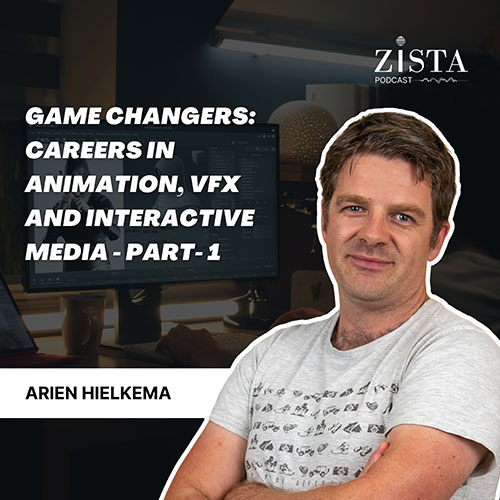Render & Reality: Behind the Game Scenes – Part 1
Welcome back to The Zista Podcast! In this episode, “Render and Reality: Behind the Game Scenes,” features Jinesha Gandhi and Redhill Games.
Jinesha gives us an insider’s look into the game development process, explaining how games evolve from creative concepts to thrilling experiences that captivate players globally. She discusses the integration of technical skill and artistic vision, and the role of player feedback in shaping game design.
Join us for a compelling journey into the world of game development, offering invaluable insights for anyone interested in the craft of video games.
Welcome to our latest episode on The Zista Podcast on, “Render and Reality: Behind the Game Scenes.” We’re excited to have Jinesha Gandhi, a senior producer with over a decade of experience in the gaming industry. Jinesha has made significant contributions at Redhill Games and has collaborated with renowned brands such as Ubisoft and Massive Entertainment.
In this episode, Jinesha brings us into the game studio’s world, sharing her comprehensive experience in turning concepts into compelling gameplay experiences. She discusses the sparks of inspiration that drove her into game development, her educational path, and the steps involved in bringing a game from the drawing board to players’ screens.
Listen as Jinesha breaks down the game development process, revealing the essential balance between technical prowess and creative vision. She highlights key strategies for tackling challenges and maximizing joy throughout the development cycle. Moreover, Jinesha will share how understanding player feedback and market trends has influenced her approach to game design, offering invaluable insights for both aspiring developers and seasoned industry professionals.
Join us to gain a behind-the-scenes look at game development, packed with actionable advice and inspiring stories, tailored for anyone looking to master the art of making games.
KEY TAKEAWAYS
- In industries like game development, self-taught skills and hands-on experience are as valuable as formal education. Engage in hands-on learning through internships or personal projects to obtain practical experience.
- Knowing how different teams (artists, programmers, designers) interact and depend on each other is crucial. This awareness helps in managing projects efficiently and can prevent missteps during development.
- Flexibility is key in game development. Changes in project direction, like adjusting game features, require quick adaptation and effective communication across teams.
- Familiarize yourself with all stages of game development—from ideation and securing funding, through pre-production and production, to polishing and release. Each phase has distinct challenges and learning opportunities.
- In game design, balancing artistic vision with realism is essential, especially when establishing a new intellectual property (IP). Engage in creative discussions and be open to external feedback to refine the game’s visual and functional appeal.
- The technology and methodologies in game development are constantly evolving. Commit to lifelong learning to keep your skills relevant and to remain competitive in the field.
Questions
Q1. How did your early experiences shape your career in game development?
A: Jinesha shares that her journey into game development was inspired by her childhood experiences. Diagnosed with dyslexia at a young age, she found solace and fascination in drawing and the world of 3-D graphics. Her early exposure to games like Mario Kart and various TV shows sparked her interest in 3-D animation. While pursuing a bachelor’s degree in business management, Jinesha took a course in 3-D animation, which led to her first job as a 3-D artist with Red Chillies in Mumbai. Although she gained valuable experience, the content did not fully satisfy her creative aspirations. She returned to her hometown of Ahmedabad, where she transitioned to mobile gaming and project management. It was in this role that she realized her true passion lay in game development, fueling her dream to become a producer in the video game industry.
Q2. How has your educational background influenced your career as a game developer?
A: Jinesha explains that when she was initially interested in studying video game development, there were no dedicated courses available in India. Consequently, her education in game development was largely self-directed, acquired through hands-on experience at work. This involved learning from both successes and failures, and engaging with colleagues in the industry. While her formal education provided a foundational understanding of 3-D concepts, which was beneficial, much of her knowledge about the intricate connections between programming, design, and testing in gaming came from on-the-job learning. Today, she notes that there are more educational opportunities for aspiring developers to explore their interest in the field.
Q3. What is a crucial aspect of game development that aspiring developers should understand?
A: Jinesha highlights that many people are not aware of the interconnected nature of game development. In her experience, a game project involves collaboration between multiple teams—artists, animators, character artists, VFX specialists, game designers, level designers, and programmers. Each team brings a unique skill set, and understanding the dependencies among these teams is critical. A single change or error can create a ripple effect throughout the development process. This complex interplay is typically learned through hands-on experience and making mistakes. Jinesha emphasizes the importance of always considering the player’s perspective and focusing on delivering a complete, engaging experience, as the ultimate goal of game development is to deliver an experience that resonates with and captivates players.
Q4. Could you describe a mistake made during game development and how it was resolved?
A: Jinesha details the complex process of trial and error in game development, emphasizing the collaborative efforts across various teams. She recounts an incident where the design team initially planned for a game mode that included a combat feature allowing players to stab enemies. As the design, art, and programming teams began developing this feature, significant progress was made. However, the design team later shifted their preference from stabbing to punching. This change necessitated a comprehensive alteration across multiple departments: animators had to create new punch animations, rigging artists adjusted the character movements accordingly, character artists reviewed the visual impact, and programmers rewrote the code to accommodate the new punching motion. This example highlights how a seemingly minor change can cascade, affecting many aspects of development. As producers, their responsibility is to manage these changes effectively, ensuring they are well-coordinated and that teams do not deviate unnecessarily from the plan.
Q5. How does a game idea evolve from concept to completion?
A: Jinesha outlines the multi-stage journey of a game from inception to the final product, noting that processes can vary across different companies. Initially, the concept begins with securing funding, as developing a new game is a costly endeavor. Key personnel like the Art Director, Design Director, Game Director, Creative Director, and Narrative Director collaborate to perform sanity checks on the proposed idea to ensure its feasibility and appeal.
Once the idea is approved, the team moves into the pre-production phase. This stage involves creating minimum viable products, storyboarding, and sketching to flesh out the concept. The team uses tools like Unreal Engine to develop basic “gray box” prototypes, which help them assess whether the game is enjoyable and the concept is solid. During pre-production, producers play a crucial role in enforcing deadlines and guiding the team toward refining their ideas into a playable level that, while not finalized in design, makes sense from a gameplay perspective.
Following successful pre-production, the project advances to the production phase. This stage is more tangible, involving the detailed design and development of the game. Different teams work under the guidance of their leads to elaborate on every aspect of the game, from level design and story creation to audio and VFX. The production stage is marked by regular updates and milestones, including alpha versions that provide a complete but unpolished view of the game, and beta versions that are closer to the final product but still require fine-tuning.
The final stages involve extensive polishing and bug fixing. The duration of this process varies significantly depending on the platform and scale of the game. For instance, AAA console games like “God of War” may require up to five years of development due to their complexity and depth, while mobile games generally have shorter cycles due to their smaller scale and frequent updates.
Throughout these stages, constant communication and coordination among all teams are essential to ensure the game progresses smoothly towards completion, meeting both creative and technical benchmarks set by the developers and stakeholders.
Q6. What brings you the most joy in the game development process?
A: Jinesha finds the most joy in seeing players finally engage with the game. The culmination of all the hard work and the moment when the game or its trailer is released to the public is particularly rewarding for her. While she acknowledges that not every aspect of the game will appeal to every player, the sheer accomplishment of having completed a project and made it available is fulfilling. She often shares with people curious about her career that despite the inherent chaos and challenges of game development, the process is enjoyable and rich with learning opportunities. This experience of bringing a concept to life and sharing it with the world encapsulates the joy of game development for her.
Q7. How do you balance realism and artistic style in a game’s visual design?
A: Jinesha explains that the approach to balancing realism and artistic style in game visual design largely depends on whether the game is an existing title or a new intellectual property (IP). For games that are already established, the process is relatively straightforward: designers simply adapt to and continue the pre-existing artistic style. However, for a new IP, the process involves extensive discussions among the creative leads who are responsible for making key decisions about the game’s visual direction. These discussions are crucial as they determine what will visually appeal to the audience while staying true to the game’s conceptual vision.
In some cases, companies will bring in external artists under non-disclosure agreements (NDAs) to contribute to the design process or to gather feedback on different aspects like character design, environmental art, and overall style. This feedback can be vital in shaping the artistic direction of the game.
Pre-production is the stage where most of these discussions and trials occur, as it’s essential to establish a cohesive art style before moving into full production. Jinesha cites Blizzard Entertainment as an example of a company with a distinctive art style, recognizable in games like World of Warcraft, which helps set their titles apart from others in the industry. This level of uniqueness in visual design is something that many companies aspire to achieve, as it can significantly define a game’s identity in a crowded market.




